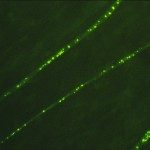Link to Pubmed [PMID] – 22894835
Sci Signal 2012 Aug;5(237):ra58
PTEN (phosphatase and tensin homolog deleted on chromosome 10) and MAST2 (microtubule-associated serine and threonine kinase 2) interact with each other through the PDZ domain of MAST2 (MAST2-PDZ) and the carboxyl-terminal (C-terminal) PDZ domain-binding site (PDZ-BS) of PTEN. These two proteins function as negative regulators of cell survival pathways, and silencing of either one promotes neuronal survival. In human neuroblastoma cells infected with rabies virus (RABV), the C-terminal PDZ domain of the viral glycoprotein (G protein) can target MAST2-PDZ, and RABV infection triggers neuronal survival in a PDZ-BS-dependent fashion. These findings suggest that the PTEN-MAST2 complex inhibits neuronal survival and that viral G protein disrupts this complex through competition with PTEN for binding to MAST2-PDZ. We showed that the C-terminal sequences of PTEN and the viral G protein bound to MAST2-PDZ with similar affinities. Nuclear magnetic resonance structures of these complexes exhibited similar large interaction surfaces, providing a structural basis for their binding specificities. Additionally, the viral G protein promoted the nuclear exclusion of PTEN in infected neuroblastoma cells in a PDZ-BS-dependent manner without altering total PTEN abundance. These findings suggest that formation of the PTEN-MAST2 complex is specifically affected by the viral G protein and emphasize how disruption of a critical protein-protein interaction regulates intracellular PTEN trafficking. In turn, the data show how the viral protein might be used to decipher the underlying molecular mechanisms and to clarify how the subcellular localization of PTEN regulates neuronal survival.




